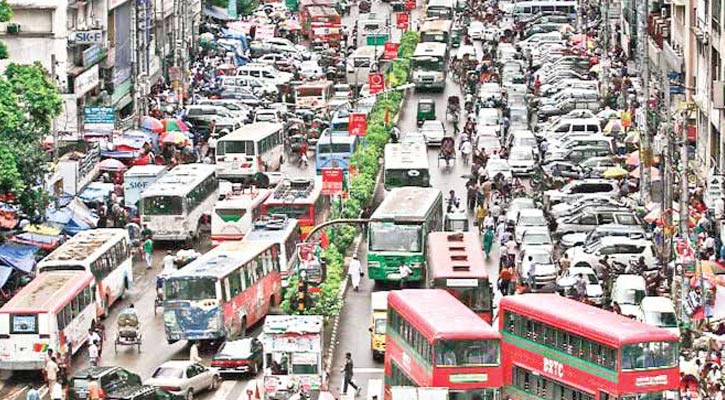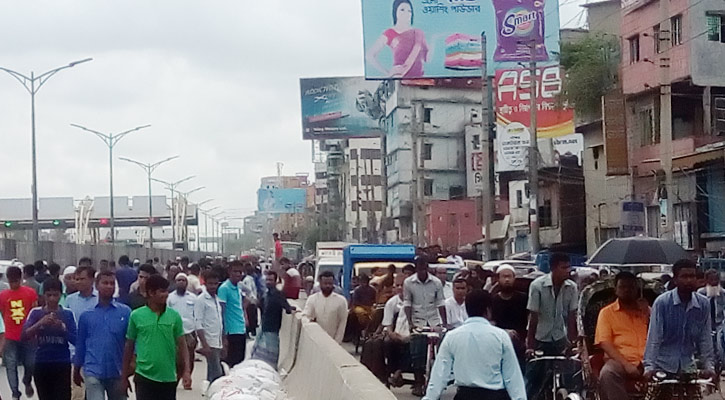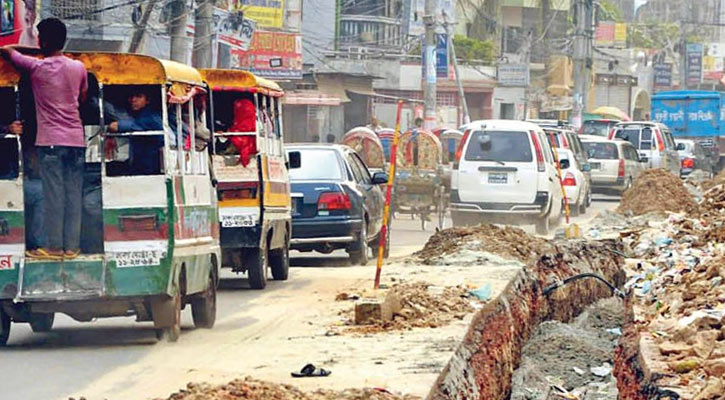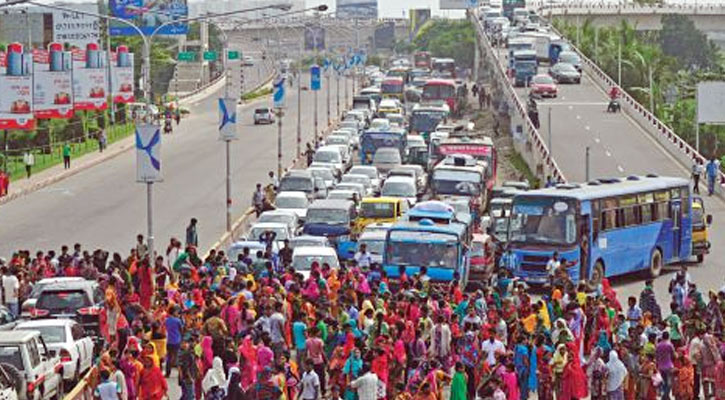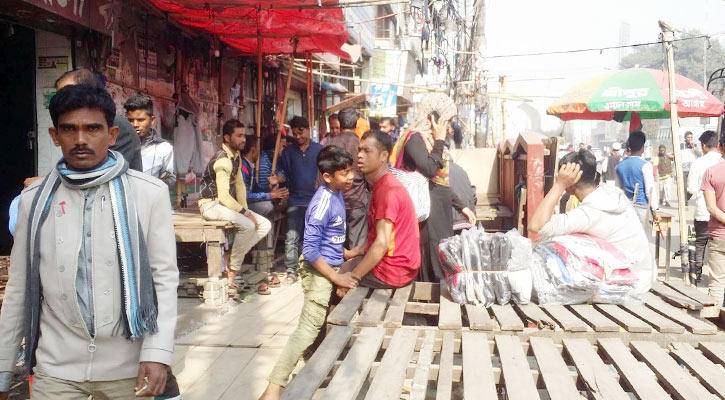Homo Sapiens
ELITE MEMBER

- Joined
- Feb 3, 2015
- Messages
- 9,641
- Reaction score
- -1
- Country
- Location
http://www.thedailystar.net/drivers-economy/story-significant-progress-1364827
12:00 AM, February 23, 2017 / LAST MODIFIED: 12:00 AM, February 23, 2017
DOMESTIC CONNECTIVITY IN BANGLADESH
A story of significant progress

Nazrul Islam
The development of domestic transport and communication is a prerequisite of economic advancement of a country. In general, means of transport influences the distribution of both economic production and population. The physical geographical condition of a country in turn largely determines the nature of its transportation. Bangladesh is fortunate to be served by various means of communication - waterways, railways, roads, and airways - each having its own advantages and disadvantages.
Inland water transport
Bangladesh is a riverine country. It is crisscrossed by over 700 rivers, which include the mighty Ganges (Padma), the Jamuna (Brahmaputra), the Meghna, and the Karnaphuli and their innumerable tributaries and distributaries. These rivers have for centuries provided good means of water transport, but at the same time have made building of roads and railways difficult and expensive. The rivers provided excellent domestic communication in the past and are still one of the major means of transport today. There is however a wide variation in the length of navigable waterways during the rainy season when vast areas of the land are inundated and the dry season when many rivers are rendered unsuitable for navigation, especially for larger water vessels. The navigability of many rivers, including the major ones, has been significantly reduced due to the natural hydro-geographical dynamics, and human intervention both outside and inside the country.
Currently, 8433 km of waterways is navigable by large vessels during the rainy season and only about 4800 km during the dry season. Waterways serve both people and goods movement.
Despite problems of navigability, the volume of both cargo and passengers has increased significantly over the recent decades. The volume of cargo increased from only 5.69 million tonnes in 1994-95 to 35.86 million tonnes in 2011-12, a nearly six-fold increase in 17 years. The growth in volume of passengers was equally significant. It increased from 68.01 million in 1994-95 to 350.98 million in 2011-2012, also nearly a six-fold growth.
Dhaka, the capital city, is centrally located and enjoys excellent waterway connectivity to almost all major corners of the country. Large passenger water vessels with modern facilities travel through a number of routes. The more important popular routes are Dhaka-Barisal, Dhaka-Bhola, Dhaka-Patuakhali, Dhaka-Khulna and other southern locations. There are now tourist boats making journeys to the Sundarbans and to the coastal islands. There are also water-transport routes between Bangladesh water ports and Kolkata. Transit facilities for India have been introduced through Bangladesh water and land routes.
The cargo routes are numerous, well over 100 with similar number of river stations or ghats, and river ports, Dhaka, Narayanganj, Chandpur, Bhairab, Barisal, Bhola, Khulna, Chalna, Mongla, Patuakhali and Chittagong being the busiest ones. Chilmari, Fulchari, Bahadurabad Ghat, Chhatak, Jagannathganj Ghat, Rajshahi, Sirajganj, Nagarbari, Bheramara, Aricha, Goalondo, Daudkandi, Madaripur, Gopalganj, Sandwip, Hatia, Barguna, Cox's Bazar, etc. are the other important river ports. The international ports, Chittagong and Mongla, also serve as inland ports.
Bangladesh railway is expected to experience a revolutionary expansion when the under-construction Padma Multipurpose Bridge is completed (hopefully in 2018), as it will also include a railway track and shall connect the hitherto unserved region in southern Bangladesh. The railway today has some 443 stations, with a number of junctions.
The inland water transportation is managed both by the public sector [Inland Water Transport Authority (IWTA)] and the private sector, which has a much larger share (over 90 percent).
At one time the country had several hundred thousand country boats, most of which have been converted as engine-driven boats, making life easier for the boatmen. The number of registered water vessels is over 9000. Some private water transport operators have floated very large vessels with capacity for over 1000 passengers in normal times and well over three to four times the capacity during Eid journeys. Travel safety at such times is a low priority.
Inland water transport is constantly facing problems of safe navigability due to siltation of the rivers. In certain routes, even in the large rivers, expensive dredging operations need to be carried out. Rivers like Teesta, Karotoa, Doodkumar, in the northern districts experience the closure of navigation routes. Major river crossings even along the major road transportation routes also suffer due to erosion of ferry ghats and lowering of draft level due to siltation. The Bangladesh Delta Plan 2100 is proposing large scale dredging for many of the rivers and to improve inland water transportation on a long-term basis.
Rail transport
The railway was introduced in the country by the British as early as 1862 (with a short length of 53.12 km between Darshana and Jagati in the south-west to be followed soon by a line between Narayanganj and Dhaka in the centre and another two lengths between Chittagong and Comilla and Laksam and Chandpur in the east). The basic structure of the railway system that exists in Bangladesh today was established during the British period, well within 1947. In 1951, the total length of railways in the Bangladesh territory was 2616 km, of which 805 km was broad gauge (in the western region), 1773 km was metre gauge (east of the Jamuna River) and only 32 km was narrow gauge (in Khulna-Bagerhat). The narrow gauge railway was later converted to metre gauge. The total length of the railways increased marginally to 2791 km in 2011-12 of which 659 km was broad gauge, 1757 km was metre gauge and 375 km was dual gauge. With the construction of the Bangabandhu Multi Purpose Bridge (Jamuna Setu) in 2001, arrangement was made for dual gauge (both broad and metre gauge in the same track). The Bangabandhu Bridge has enabled a link between the western and eastern sectors of the railways. The railways provide comparatively safer and cheaper transportation of people and goods, than road transportation. The country is reasonably well-connected by the railway; the central focus is Dhaka although during the British era, rail routes (and also steamer routes) were oriented towards Kolkata, which was the principal port for export, particularly of jute from the present Bangladesh territory.
Bangladesh railway is expected to experience a revolutionary expansion when the under-construction Padma Multipurpose Bridge is completed (hopefully in 2018), as it will also include a railway track and shall connect the hitherto unserved region in southern Bangladesh. The railway today has some 443 stations, with a number of junctions.
Dhaka, Chittagong, Comilla, Akhaura, Barisal, Sylhet, Iswardi, Rajbari, Parbatipur, Jessore and Khulna are some of the important railway stations. The three Chittagong Hill Districts are not served by railway.
The volume of railway passengers has increased from 39.47 million in 1994-95 to 66.13 million in 2011-12, but the volume of freight has recorded decline over the years, such as from 3.28 million tonnes in 2007-08 to 2.19 million tonnes in 2011-12. The loss of freight by railways seems to have been compensated by its increase in the road and waterway sectors. The recent thinking in the government is in the favour of expansion of the railways, both in terms of mileage and quality. High speed inter-city train services between Dhaka and other major destinations are being thought about. Rail transportation is a fully public sector operation and characterised by poor governance. Some examples of its recent introductions are the Demu service between Kamalapur/Dhaka and Narayanganj. The Dhaka-Kolkata Friendship Train has been a fairly successful venture.

Roads
Being a delta and crisscrossed by innumerable rivers, some of which are several kilometres in width with shifting courses and experiencing annual flooding, building roads has not been easy in Bangladesh. Floods even wash away existing roads and bridges. Indeed there were only a few pucca roads, even as recent as in 1947, when the total length of such roads was only 480 km, the longest stretch being the 56.32 km road between Sylhet and Tamabil in the north-east. The total length of kutcha roads at that time in the whole country was 36000 km. The situation had improved somewhat by 1970, when the country (or the province of the then East Pakistan) had 3860 km of pucca roads. But the situation has changed dramatically in the last four decades since independence. The war ravaged road infrastructure was not only fully restored but in fact radically transformed. There was policy support in favour of road transportation, over railways and waterways. There was also pressure from the growing private sector and foreign motor vehicle companies and their governments. People in general also seemed to prefer road transportation, speed and accessibility being prime factors. Roads, pucca or semi-pucca (brick soled) or at least kutcha roads now connect almost all (80,000 more or less) villages in the country. Motorable pucca roads connect all 490 Upazila headquarters and nearly all (of the 4550) Union centres. The few which are not accessible by road (in the southern districts) are reached by waterways. Indeed, Bangladesh today is said to have one of the highest road densities (mileage against unit area of land surface), although it may not enjoy a high ratio of length of road to population.
Because of geomorphologic reasons road building is expensive in Bangladesh, but a kilometre of road in Bangladesh serves a higher number of people than in a country of thin population density (such as USA, Canada, Australia or Saudi Arabia). Public roads in Bangladesh are developed by either the Roads and Highways Department (RHD) or the Local Government Engineering Department (LGED). Roads are of several categories depending mainly on crest-width. RHD is responsible for building national highways (12.2 metre in width), regional highways (11.0 metres) and Zila roads (7.3 metres), while LGED is responsible for Upazila roads (7.3 metres), Union roads (4.9 metres) and village roads (3.7 metres). All national highways, regional highways and nearly half of the Zila roads are bituminised and the rest are brick-soled. The total length of roads in Bangladesh today is over 354,890 km, with 3813 km of national highways, 4247 km of regional highways, 13,242 km of Zila roads (of RHD), 39,756 km of Upazila roads, 46,259 km of Union roads and 247,574 km of village roads, under LGED. On an average each of the nearly 80,000 villages has almost 4.44 km of road length and there is a kilometre of road for about 450 Bangladeshis (assuming total population being 160 million). These should be respectable figures for a lower middle income country. However, the per capita availability of bituminous roads is very low.
With Bangladesh being a country of a large population and experiencing rapid economic growth, the movements of people and goods have increased. Even with expansion of road network, mileage and width of roads, the capacity of roads is far short of the need and demand. For reasons of geography (mainly presence of rivers, floods, erosion etc.), shortage of financial resources (investment in infrastructure), inadequacy of technological knowledge, management weakness (especially in monitoring and maintenance) and alleged widespread system loss (i.e. corruption), the quality of road transportation service is unsatisfactory. Most alarming is the situation of safety on roads, with increasing incidents of fatal accidents. Highway traffic discipline is seriously lacking.
Nevertheless, the government gives high priority to the road transportation sector. To meet the growing demand several highways (like Dhaka-Chittagong, Dhaka-Mymensingh, Dhaka-Sylhet, Dhaka-Rajshahi, etc.) are being upgraded to four-lane highways. Long-distance elevated expressways are also being thought of. The Padma Bridge will dramatically improve road connectivity from the capital to the south and southwestern regions of the country.
Bangladesh geographically is a small country with a roughly rectangular shape. Its capital Dhaka is almost in the geographical centre, and all national highways radiate out from Dhaka. Railways, river routes, roads, air routes all focus on Dhaka, making it a critically important multi-modal hub.
The road network of national highways is organised along a number of corridors: Dhaka-Chittagong (to the south-east), Dhaka-Sylhet (to the north-east), Dhaka-Rajshahi/ Rangpur/ Dinajpur (to the north-west), and Dhaka-Barisal-Barguna (to the south). In fact, almost all districts are directly accessible from Dhaka by road. The two farthest district towns, Cox's Bazar in the southeast and Panchagarh in the north-east, are less than 400 km away from the capital.
The capital is also connected with Kolkata by direct bus route. Similar routes are also planned for Agartola in Tripura. Bangladesh is also in the Asian highway connectivity.
Domestic air transport
Air transport in the present Bangladesh territory started with military aviation during World War II, when a few airstrips were built in Dhaka, Comilla, Feni, Chittagong, Cox's Bazar, Chakaria, Sylhet, Jessore, Rajshahi and Lalmonirhat. Most of these airstrips currently serve as modernised domestic airports. Nine are operative: Dhaka, Chittagong and Sylhet (which are also international airports), Cox's Bazar, Saidpur, Rajshahi, Iswardi, Jessore and Barisal. The Civil Aviation Authority is responsible for air transport management. With growing economy and increase in private income, the demand for domestic air transport has increased significantly. Biman Bangladesh Airlines in the public sector is the principal operator, while a number of private airlines also provide service. Some private airlines that began business in the 1990s have closed service, while a few new ones are now in operation. There are also private helicopter services available commercially.
In conclusion, domestic connectivity in Bangladesh has experienced quite significant progress in the last four and a half decades since independence. We, however, feel that in all modes in the sector, safety concerns must be given priority attention. Overall management improvement is also critical.
The writer is Retired Professor of Geography and Environment, University of Dhaka.
12:00 AM, February 23, 2017 / LAST MODIFIED: 12:00 AM, February 23, 2017
DOMESTIC CONNECTIVITY IN BANGLADESH
A story of significant progress

Nazrul Islam
The development of domestic transport and communication is a prerequisite of economic advancement of a country. In general, means of transport influences the distribution of both economic production and population. The physical geographical condition of a country in turn largely determines the nature of its transportation. Bangladesh is fortunate to be served by various means of communication - waterways, railways, roads, and airways - each having its own advantages and disadvantages.
Inland water transport
Bangladesh is a riverine country. It is crisscrossed by over 700 rivers, which include the mighty Ganges (Padma), the Jamuna (Brahmaputra), the Meghna, and the Karnaphuli and their innumerable tributaries and distributaries. These rivers have for centuries provided good means of water transport, but at the same time have made building of roads and railways difficult and expensive. The rivers provided excellent domestic communication in the past and are still one of the major means of transport today. There is however a wide variation in the length of navigable waterways during the rainy season when vast areas of the land are inundated and the dry season when many rivers are rendered unsuitable for navigation, especially for larger water vessels. The navigability of many rivers, including the major ones, has been significantly reduced due to the natural hydro-geographical dynamics, and human intervention both outside and inside the country.
Currently, 8433 km of waterways is navigable by large vessels during the rainy season and only about 4800 km during the dry season. Waterways serve both people and goods movement.
Despite problems of navigability, the volume of both cargo and passengers has increased significantly over the recent decades. The volume of cargo increased from only 5.69 million tonnes in 1994-95 to 35.86 million tonnes in 2011-12, a nearly six-fold increase in 17 years. The growth in volume of passengers was equally significant. It increased from 68.01 million in 1994-95 to 350.98 million in 2011-2012, also nearly a six-fold growth.
Dhaka, the capital city, is centrally located and enjoys excellent waterway connectivity to almost all major corners of the country. Large passenger water vessels with modern facilities travel through a number of routes. The more important popular routes are Dhaka-Barisal, Dhaka-Bhola, Dhaka-Patuakhali, Dhaka-Khulna and other southern locations. There are now tourist boats making journeys to the Sundarbans and to the coastal islands. There are also water-transport routes between Bangladesh water ports and Kolkata. Transit facilities for India have been introduced through Bangladesh water and land routes.
The cargo routes are numerous, well over 100 with similar number of river stations or ghats, and river ports, Dhaka, Narayanganj, Chandpur, Bhairab, Barisal, Bhola, Khulna, Chalna, Mongla, Patuakhali and Chittagong being the busiest ones. Chilmari, Fulchari, Bahadurabad Ghat, Chhatak, Jagannathganj Ghat, Rajshahi, Sirajganj, Nagarbari, Bheramara, Aricha, Goalondo, Daudkandi, Madaripur, Gopalganj, Sandwip, Hatia, Barguna, Cox's Bazar, etc. are the other important river ports. The international ports, Chittagong and Mongla, also serve as inland ports.
Bangladesh railway is expected to experience a revolutionary expansion when the under-construction Padma Multipurpose Bridge is completed (hopefully in 2018), as it will also include a railway track and shall connect the hitherto unserved region in southern Bangladesh. The railway today has some 443 stations, with a number of junctions.
The inland water transportation is managed both by the public sector [Inland Water Transport Authority (IWTA)] and the private sector, which has a much larger share (over 90 percent).
At one time the country had several hundred thousand country boats, most of which have been converted as engine-driven boats, making life easier for the boatmen. The number of registered water vessels is over 9000. Some private water transport operators have floated very large vessels with capacity for over 1000 passengers in normal times and well over three to four times the capacity during Eid journeys. Travel safety at such times is a low priority.
Inland water transport is constantly facing problems of safe navigability due to siltation of the rivers. In certain routes, even in the large rivers, expensive dredging operations need to be carried out. Rivers like Teesta, Karotoa, Doodkumar, in the northern districts experience the closure of navigation routes. Major river crossings even along the major road transportation routes also suffer due to erosion of ferry ghats and lowering of draft level due to siltation. The Bangladesh Delta Plan 2100 is proposing large scale dredging for many of the rivers and to improve inland water transportation on a long-term basis.
Rail transport
The railway was introduced in the country by the British as early as 1862 (with a short length of 53.12 km between Darshana and Jagati in the south-west to be followed soon by a line between Narayanganj and Dhaka in the centre and another two lengths between Chittagong and Comilla and Laksam and Chandpur in the east). The basic structure of the railway system that exists in Bangladesh today was established during the British period, well within 1947. In 1951, the total length of railways in the Bangladesh territory was 2616 km, of which 805 km was broad gauge (in the western region), 1773 km was metre gauge (east of the Jamuna River) and only 32 km was narrow gauge (in Khulna-Bagerhat). The narrow gauge railway was later converted to metre gauge. The total length of the railways increased marginally to 2791 km in 2011-12 of which 659 km was broad gauge, 1757 km was metre gauge and 375 km was dual gauge. With the construction of the Bangabandhu Multi Purpose Bridge (Jamuna Setu) in 2001, arrangement was made for dual gauge (both broad and metre gauge in the same track). The Bangabandhu Bridge has enabled a link between the western and eastern sectors of the railways. The railways provide comparatively safer and cheaper transportation of people and goods, than road transportation. The country is reasonably well-connected by the railway; the central focus is Dhaka although during the British era, rail routes (and also steamer routes) were oriented towards Kolkata, which was the principal port for export, particularly of jute from the present Bangladesh territory.
Bangladesh railway is expected to experience a revolutionary expansion when the under-construction Padma Multipurpose Bridge is completed (hopefully in 2018), as it will also include a railway track and shall connect the hitherto unserved region in southern Bangladesh. The railway today has some 443 stations, with a number of junctions.
Dhaka, Chittagong, Comilla, Akhaura, Barisal, Sylhet, Iswardi, Rajbari, Parbatipur, Jessore and Khulna are some of the important railway stations. The three Chittagong Hill Districts are not served by railway.
The volume of railway passengers has increased from 39.47 million in 1994-95 to 66.13 million in 2011-12, but the volume of freight has recorded decline over the years, such as from 3.28 million tonnes in 2007-08 to 2.19 million tonnes in 2011-12. The loss of freight by railways seems to have been compensated by its increase in the road and waterway sectors. The recent thinking in the government is in the favour of expansion of the railways, both in terms of mileage and quality. High speed inter-city train services between Dhaka and other major destinations are being thought about. Rail transportation is a fully public sector operation and characterised by poor governance. Some examples of its recent introductions are the Demu service between Kamalapur/Dhaka and Narayanganj. The Dhaka-Kolkata Friendship Train has been a fairly successful venture.

Roads
Being a delta and crisscrossed by innumerable rivers, some of which are several kilometres in width with shifting courses and experiencing annual flooding, building roads has not been easy in Bangladesh. Floods even wash away existing roads and bridges. Indeed there were only a few pucca roads, even as recent as in 1947, when the total length of such roads was only 480 km, the longest stretch being the 56.32 km road between Sylhet and Tamabil in the north-east. The total length of kutcha roads at that time in the whole country was 36000 km. The situation had improved somewhat by 1970, when the country (or the province of the then East Pakistan) had 3860 km of pucca roads. But the situation has changed dramatically in the last four decades since independence. The war ravaged road infrastructure was not only fully restored but in fact radically transformed. There was policy support in favour of road transportation, over railways and waterways. There was also pressure from the growing private sector and foreign motor vehicle companies and their governments. People in general also seemed to prefer road transportation, speed and accessibility being prime factors. Roads, pucca or semi-pucca (brick soled) or at least kutcha roads now connect almost all (80,000 more or less) villages in the country. Motorable pucca roads connect all 490 Upazila headquarters and nearly all (of the 4550) Union centres. The few which are not accessible by road (in the southern districts) are reached by waterways. Indeed, Bangladesh today is said to have one of the highest road densities (mileage against unit area of land surface), although it may not enjoy a high ratio of length of road to population.
Because of geomorphologic reasons road building is expensive in Bangladesh, but a kilometre of road in Bangladesh serves a higher number of people than in a country of thin population density (such as USA, Canada, Australia or Saudi Arabia). Public roads in Bangladesh are developed by either the Roads and Highways Department (RHD) or the Local Government Engineering Department (LGED). Roads are of several categories depending mainly on crest-width. RHD is responsible for building national highways (12.2 metre in width), regional highways (11.0 metres) and Zila roads (7.3 metres), while LGED is responsible for Upazila roads (7.3 metres), Union roads (4.9 metres) and village roads (3.7 metres). All national highways, regional highways and nearly half of the Zila roads are bituminised and the rest are brick-soled. The total length of roads in Bangladesh today is over 354,890 km, with 3813 km of national highways, 4247 km of regional highways, 13,242 km of Zila roads (of RHD), 39,756 km of Upazila roads, 46,259 km of Union roads and 247,574 km of village roads, under LGED. On an average each of the nearly 80,000 villages has almost 4.44 km of road length and there is a kilometre of road for about 450 Bangladeshis (assuming total population being 160 million). These should be respectable figures for a lower middle income country. However, the per capita availability of bituminous roads is very low.
With Bangladesh being a country of a large population and experiencing rapid economic growth, the movements of people and goods have increased. Even with expansion of road network, mileage and width of roads, the capacity of roads is far short of the need and demand. For reasons of geography (mainly presence of rivers, floods, erosion etc.), shortage of financial resources (investment in infrastructure), inadequacy of technological knowledge, management weakness (especially in monitoring and maintenance) and alleged widespread system loss (i.e. corruption), the quality of road transportation service is unsatisfactory. Most alarming is the situation of safety on roads, with increasing incidents of fatal accidents. Highway traffic discipline is seriously lacking.
Nevertheless, the government gives high priority to the road transportation sector. To meet the growing demand several highways (like Dhaka-Chittagong, Dhaka-Mymensingh, Dhaka-Sylhet, Dhaka-Rajshahi, etc.) are being upgraded to four-lane highways. Long-distance elevated expressways are also being thought of. The Padma Bridge will dramatically improve road connectivity from the capital to the south and southwestern regions of the country.
Bangladesh geographically is a small country with a roughly rectangular shape. Its capital Dhaka is almost in the geographical centre, and all national highways radiate out from Dhaka. Railways, river routes, roads, air routes all focus on Dhaka, making it a critically important multi-modal hub.
The road network of national highways is organised along a number of corridors: Dhaka-Chittagong (to the south-east), Dhaka-Sylhet (to the north-east), Dhaka-Rajshahi/ Rangpur/ Dinajpur (to the north-west), and Dhaka-Barisal-Barguna (to the south). In fact, almost all districts are directly accessible from Dhaka by road. The two farthest district towns, Cox's Bazar in the southeast and Panchagarh in the north-east, are less than 400 km away from the capital.
The capital is also connected with Kolkata by direct bus route. Similar routes are also planned for Agartola in Tripura. Bangladesh is also in the Asian highway connectivity.
Domestic air transport
Air transport in the present Bangladesh territory started with military aviation during World War II, when a few airstrips were built in Dhaka, Comilla, Feni, Chittagong, Cox's Bazar, Chakaria, Sylhet, Jessore, Rajshahi and Lalmonirhat. Most of these airstrips currently serve as modernised domestic airports. Nine are operative: Dhaka, Chittagong and Sylhet (which are also international airports), Cox's Bazar, Saidpur, Rajshahi, Iswardi, Jessore and Barisal. The Civil Aviation Authority is responsible for air transport management. With growing economy and increase in private income, the demand for domestic air transport has increased significantly. Biman Bangladesh Airlines in the public sector is the principal operator, while a number of private airlines also provide service. Some private airlines that began business in the 1990s have closed service, while a few new ones are now in operation. There are also private helicopter services available commercially.
In conclusion, domestic connectivity in Bangladesh has experienced quite significant progress in the last four and a half decades since independence. We, however, feel that in all modes in the sector, safety concerns must be given priority attention. Overall management improvement is also critical.
The writer is Retired Professor of Geography and Environment, University of Dhaka.
Last edited:






